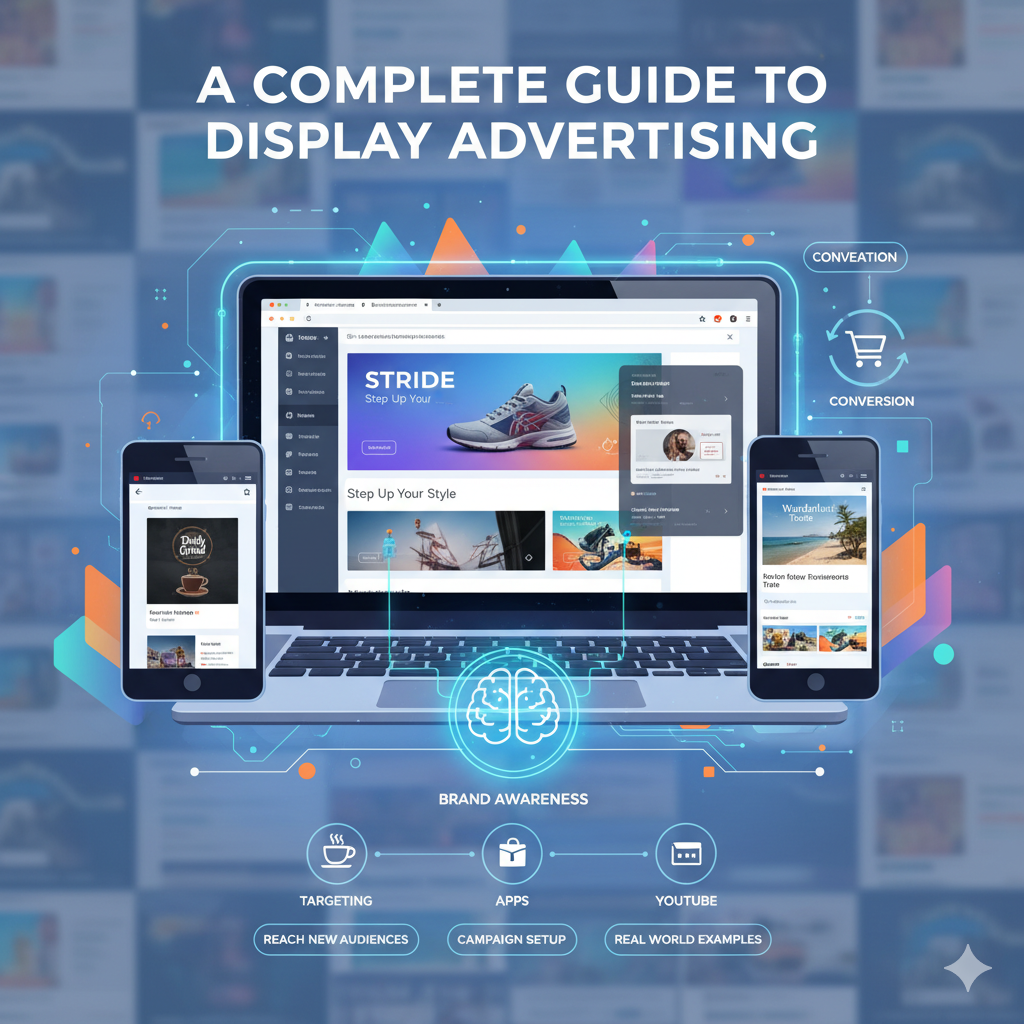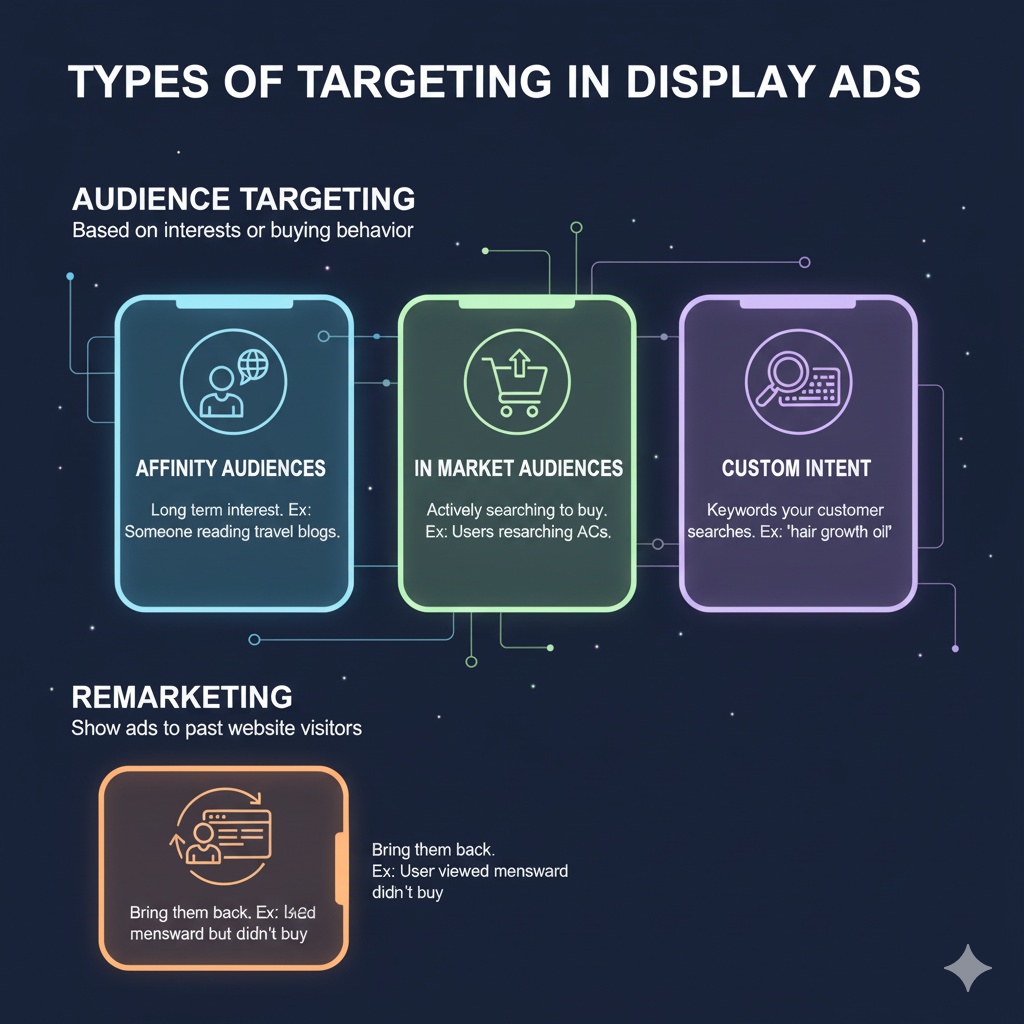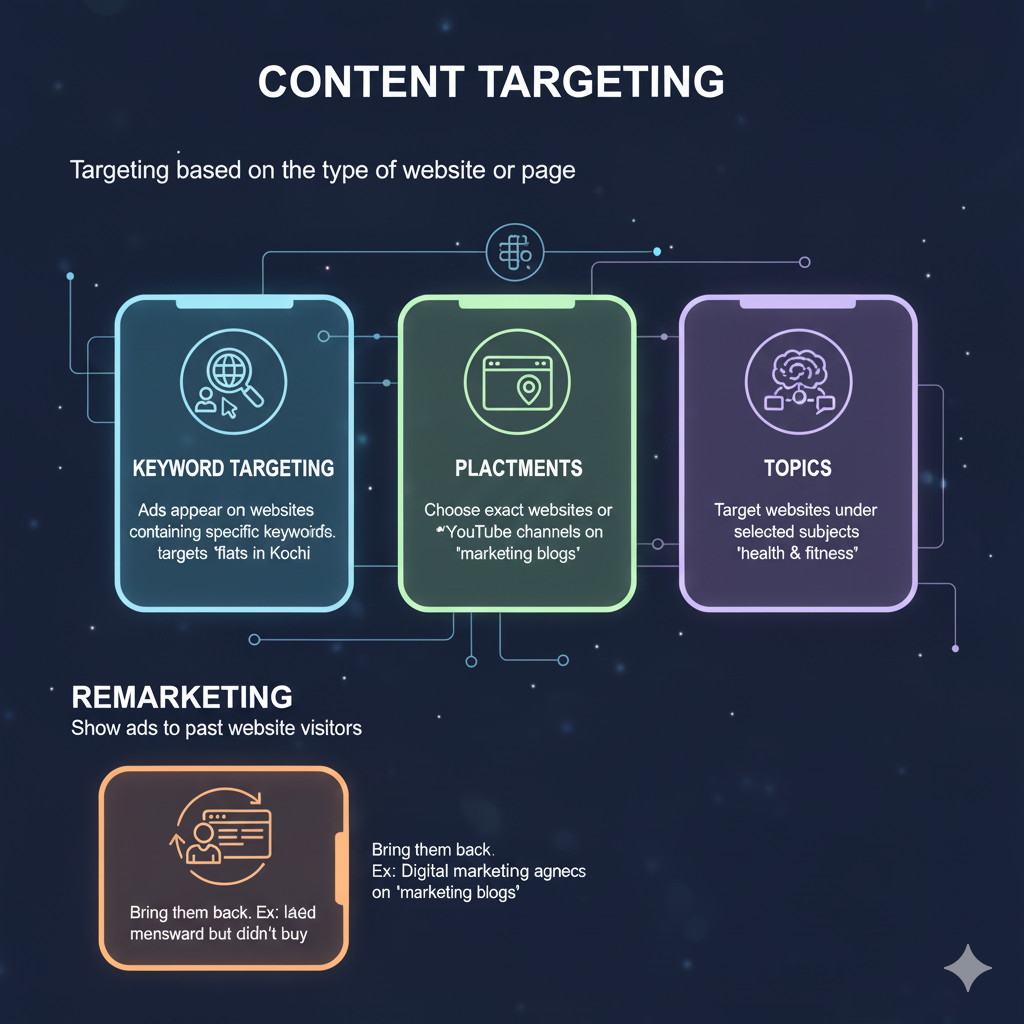
Display advertising is one of the most effective ways to visually promote your brand across websites, apps, and YouTube. These ads help businesses reach new audiences, create brand awareness, and bring users back to the website. In this blog, you will learn how display ads work, their benefits, targeting methods, how to set up a campaign, and real world examples.
What Are Display Ads
Display ads are visual ads that appear in image, banner, or video format. These ads show on the Google Display Network which contains millions of websites. Display ads help brands reach people even when they are not actively searching for the product.
Example
You visit a website to check shoes and later you see the same shoe ads on news websites and YouTube. This is a display retargeting ad.
How Display Ads Work

Google Display Network
Google Display Network or GDN is the system that decides where your ads will appear. When you create a display campaign, Google chooses websites that match your audience, keywords, and interests.
Example
If you are promoting a travel package, GDN may place your ads on travel blogs, hotel websites, or YouTube travel channels.
How Google Decides Placement
Google uses different factors such as
- Interests of users
- Types of websites
- Topics selected
- Keywords
- Past behavior of users
Example
If someone has shown interest in buying mobile phones, Google may show ads related to accessories, covers, or similar electronics.
Benefits of Display Advertising
Brand Awareness
Display ads help your brand get noticed. Even if users do not click the ad, they see your brand multiple times which builds recall.
Example
A new clothing brand can run display ads for one month to make people recognize its logo and products.
Cost Effective
Display ads normally have low cost per click, so you can reach a large audience with a small budget.
Example
A local bakery running a display campaign for 300 per day can get thousands of impressions with very low click costs.
Perfect for Retargeting
Display ads are strong for remarketing. This means you can show ads again to people who visited your site earlier.
Example
If a user added a product to cart but did not buy, display ads can remind them to complete the purchase.
Large Reach
Your ads can appear on millions of websites and apps.
Example
A fitness brand can appear on workout blogs, health apps, and YouTube fitness videos at the same time.
Visually Attractive
Display ads are more eye catching compared to text ads.
Example
A restaurant can use high quality images of food to attract customers through display ads.
Types of Targeting in Display Ads

Audience Targeting
Used when you want to reach people based on interests or buying behavior.
Affinity Audiences
People with long term interest.
Example
Someone always reading travel content will fall under travel affinity audience.
In Market Audiences
People actively searching to buy something.
Example
Users researching air conditioners can be targeted by appliance stores.
Custom Intent
You add keywords your ideal customer searches.
Example
A hair oil brand can target keywords like hair fall solution or best hair growth oil.
Remarketing
Showing ads to people who already visited your website.
Example
Visitors who checked your mens wear category but did not purchase can be shown display ads again.
Content Targeting

Targeting based on the type of website or page.
Keyword Targeting
Ads appear on websites containing specific keywords.
Example
A real estate builder can target keywords like flats in Kochi or 3 bhk apartments.
Placements
Choose exact websites or YouTube channels.
Example
A digital marketing agency can place ads specifically on marketing blogs.
Topics
Target websites under selected subjects.
Example
A nutrition product brand can target the health and fitness topic.
How to Set Up a Display Campaign
1 Select your campaign goal such as leads, sales, traffic or awareness
2 Choose Display Campaign
3 Select country, city, or radius
4 Set your daily budget
5 Choose bidding such as maximize clicks or maximize conversions
6 Select the audience group
7 Upload images, headlines, descriptions, and logo
8 Publish the campaign
Example
A beauty store selects maximize conversions, targets women aged 18 to 35, uploads product images, and publishes a responsive display ad.
Example of a Display Campaign
A womens clothing store wants more online purchases.
Target Audience Women aged 18 to 30 interested in fashion
Location India
Budget 500 per day
Bidding Maximize Conversions
Creatives Lifestyle images of outfits
Call to Action Shop Latest Styles
Expected Output
High impressions low CPC and stable conversions from remarketing traffic.
Another Example
A real estate project can use display ads to target people searching terms like flats in Kakkanad and then retarget visitors who checked the brochure page.
Tips to Improve Display Ad Performance
1 Use high quality images
2 Keep headlines short and clear
3 Start with narrow targeting and later expand
4 Use remarketing lists for best conversion results
5 Test multiple designs and messages
6 Exclude mobile app placements if they waste budget
7 Switch to target CPA after getting enough conversions
Example
If your campaign is spending on gaming apps or kids apps, exclude them to avoid wasted budget.
Common Mistakes
- Using too many targeting layers
- Poor quality visuals
- Not testing multiple variations
- Weak call to action
- Not separating remarketing from new audience
Conclusion
Display advertising is a powerful and flexible tool that helps businesses reach the right people at the right time. It supports different marketing goals such as brand awareness, website traffic, and remarketing. Because display ads run across millions of websites and apps, they help companies stay visible throughout the customer journey.
Display ads are especially useful for businesses that depend on visual impact. For example, a clothing store can show outfit images to attract buyers, a restaurant can promote its dishes, or a real estate project can highlight 3D renders of apartments. Even service based businesses such as clinics, coaching centres, or fitness studios can use display ads to build trust and bring users back to their website.
When combined with correct targeting methods, clear messaging, and high quality creatives, display campaigns can deliver strong results at a lower cost. By testing different designs and tracking performance regularly, any business can improve its return on investment and build a strong presence online.